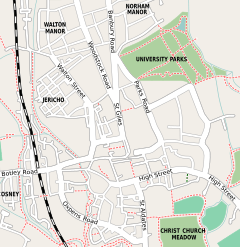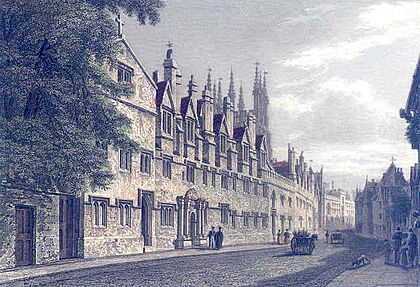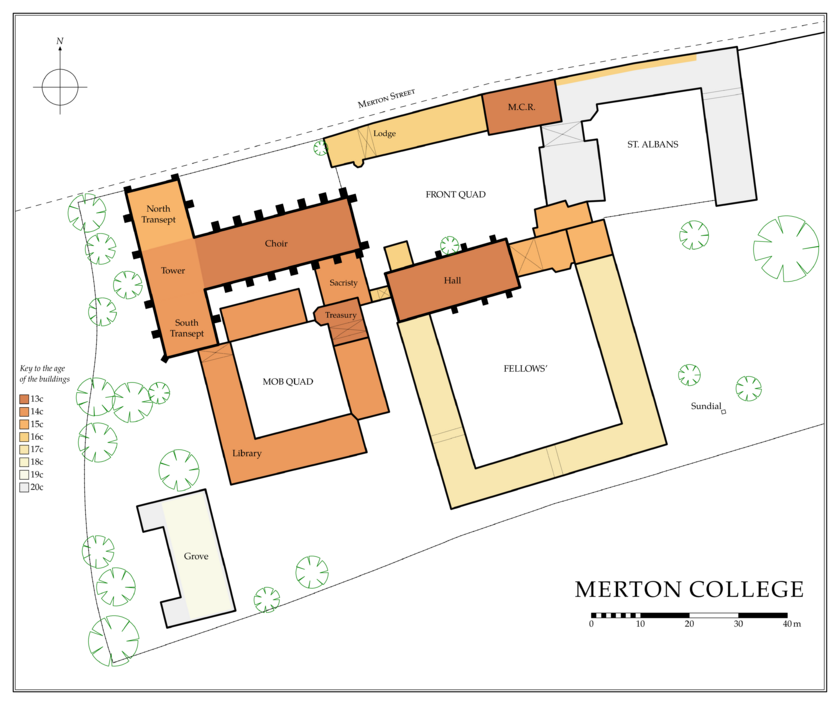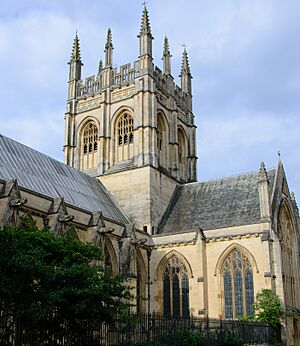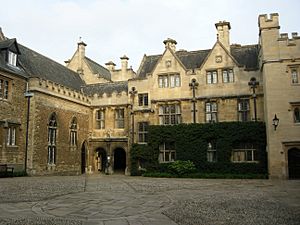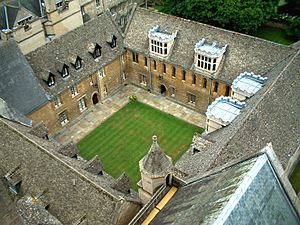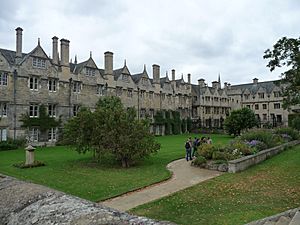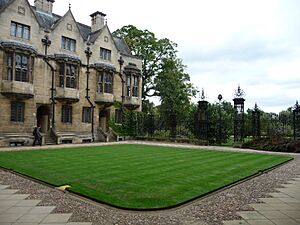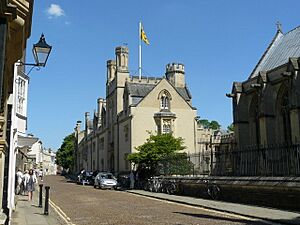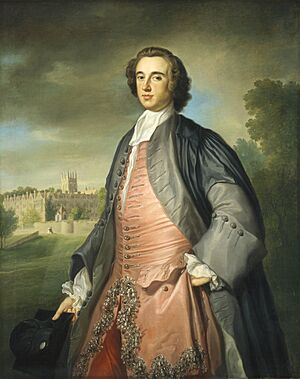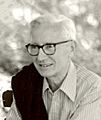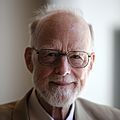Merton College, Oxford facts for kids
Quick facts for kids Merton College |
||||||||||||
|---|---|---|---|---|---|---|---|---|---|---|---|---|
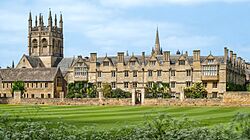
South facade as seen from Merton Field
|
||||||||||||

Blazon: Or, three chevronels party per pale, the first and third azure and gules, the second gules and azure
|
||||||||||||
|
|
||||||||||||
| University | University of Oxford | |||||||||||
| Coordinates | 51°45′04″N 1°15′07″W / 51.751°N 1.252°W | |||||||||||
| Full name | The House or College of Scholars of Merton in the University of Oxford | |||||||||||
| Latin name | Domus sive collegium scholarium de Merton in universitate Oxon. | |||||||||||
| Motto | "Qui Timet Deum Faciet Bona" ("He who fears God shall do good") | |||||||||||
| Established | 1264 | |||||||||||
| Named for | Walter de Merton | |||||||||||
| Sister college | Peterhouse, Cambridge | |||||||||||
| Warden | Jennifer Payne | |||||||||||
| Undergraduates | 291 | |||||||||||
| Postgraduates | 244 | |||||||||||
| Boat club | Boat Club | |||||||||||
| Map | ||||||||||||
Merton College is one of the oldest and most famous colleges at the University of Oxford in England. It was started in the 1260s by Walter de Merton. He was an important person who worked for King Henry III and later King Edward I. Walter de Merton created rules and set up money to support a group of scholars.
A special thing about Merton College was that it was designed to be self-governing. This meant the college could run itself, and its money was managed by its leaders and scholars. By 1274, the college was settled at its current spot in Oxford. Soon after, many buildings were constructed. The main hall, the chapel, and the first main courtyard (called Front Quad) were finished by the end of the 1200s.
Mob Quad, another courtyard at Merton, was built between 1288 and 1378. It is thought to be the oldest courtyard in Oxford. Inside Mob Quad is the Merton College Library, which opened in 1373. It is the oldest library in the world that has been used continuously by university scholars and students.
For over 700 years, Merton College was only for men. But in 1979, like many other Oxford colleges, it welcomed its first female students. In 2022, Professor Irene Tracey, who was Merton's second female head (called a Warden), became the Vice-Chancellor of the University of Oxford. After her, Professor Jennifer Payne was chosen as the new Warden in 2023.
Many famous people have studied or taught at Merton College. These include five Nobel laureates, the writer J. R. R. Tolkien (who wrote The Lord of the Rings), and Liz Truss, who was the Prime Minister of the United Kingdom for a short time in 2022. Merton is also one of the richest colleges in Oxford.
Contents
A Look Back in Time
How Merton College Began
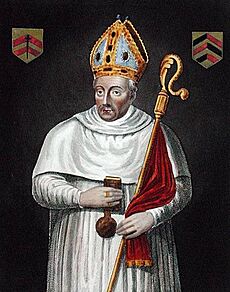
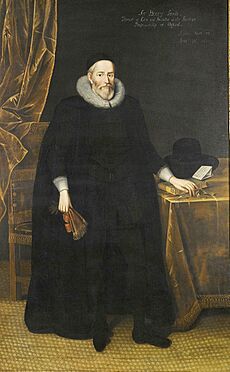
Merton College was founded in 1264 by Walter de Merton. He was a very important person, serving as the King's chief minister and also as a Bishop. Merton College claims to be the oldest college in Oxford. This claim is also made by Balliol College and University College.
One reason Merton says it's the oldest is because it was the first college to have official statutes. These were like a rulebook or constitution for how the college should be run. Merton's rules were written in 1264. Balliol and University College didn't have their own rules until the 1280s.
Merton College has had a continuous line of leaders, called wardens, since 1264. Many of these leaders helped the college grow and develop. For example, Henry Savile was a notable Warden from 1585 to 1621. He helped the college become very successful by adding new buildings and bringing in talented scholars.
In 1333, some teachers from Merton tried to start a new university in a town called Stamford. The leader of this group was William de Barnby, who had been a scholar and treasurer at Merton College.
St Alban Hall: A Neighboring Story
St Alban Hall was once a separate academic place. It was owned by a group of nuns until Merton College bought it in 1548. This happened after many monasteries were closed down in England. St Alban Hall continued to operate on its own until 1881. At that time, it officially became part of Merton College.
Merton During the English Civil War
During the English Civil War (1642-1651), Merton College was the only Oxford college to support the Parliament. This was partly because of a disagreement between the Warden, Nathaniel Brent, and the Archbishop of Canterbury, William Laud.
Warden Brent moved to London when the war began. The college buildings were then taken over by the Royalists. They used Merton to house many members of King Charles I's court, as Oxford was the Royalist capital. The King's wife, Queen Henrietta Maria, even stayed in a room that is now called the Queen's Room. A painting of Charles I hangs there today to remember this time.
After the war, Parliament took control of Oxford. Brent returned to Merton, but there were still many changes and disagreements about who should lead the college.
College Buildings and Gardens
Merton College first owned land in Surrey and Oxford. But by the 1260s, Walter de Merton bought the main part of the college's current location in Oxford. This was along the south side of what is now Merton Street. By 1274, the college was fully established on this site.
The land Walter bought included an old church and three houses. These houses now form the northern side of the Front Quad. Walter also got permission to expand the college south to the old city wall. Over time, the college bought more land around Merton Street. At one point, Merton owned all the land from where Christ Church is now, all the way to the southeast corner of the city.
Merton College Chapel
By the late 1280s, the old church on the site was falling apart. So, in about 1290, work began on a new church. The main part of the chapel, called the choir, with its huge east window, was finished by 1294. This window is a great example of how church architecture was changing at the end of the 13th century. The chapel's large size is likely because it served as both the college chapel and the local parish church until 1891.
In 2007, a new choir was started at Merton. It has sixteen student singers. The chapel is also known for its excellent sound quality. In 2013, a new organ was installed.
A tall part of the chapel, called a spire, has been in the gardens of the University of Virginia in the USA since 1928. It was given to the university to honor Thomas Jefferson's ideas about education.
Front Quad and the Hall
The college's main dining hall is the oldest building still standing. It was finished before 1277. However, most of the original building has been rebuilt over the years. The hall is still used every day for meals during term time. It is not usually open to visitors.
The Front Quad itself is probably the very first college courtyard. It has an informal design, which shows its original purpose as back gardens for the houses Walter de Merton bought. You can still see a flagstone marked "Well" in the northeast corner, reminding us of its past.
Mob Quad and Library
Visitors to Merton are often told that Mob Quad is the oldest courtyard at any Oxford or Cambridge college. It was built in three stages, with the library being completed between 1373 and 1378. However, Merton's own Front Quad was likely enclosed earlier, even if its design was less planned.
The Merton College Library, located in Mob Quad, is the oldest continuously used library for university academics and students in the world.
Fellows' Quad
The most impressive courtyard at Merton is the Fellows' Quadrangle. It is located just south of the main hall. This quad was built by Henry Savile in the early 1600s. The first stone was laid in 1608, and the work was mostly finished by 1610. The southern entrance has a tall tower with different styles of columns. This design was probably inspired by Italian buildings Savile saw on his travels.
Other Buildings
Most of the other buildings at Merton were built in the Victorian era (1837-1901) or later. These include St. Alban's Quad, which was built where the old St Alban Hall used to be. There is also the Grove building, and several buildings north of Merton Street. These include a real tennis court and the Old Warden's Lodgings.
TS Eliot Lecture Theatre
The TS Eliot Lecture Theatre is a modern lecture hall named after T. S. Eliot, a famous poet and former member of the college. It opened in 2010. Inside, there is a statue of the writer. The entrance area has a special light display that shows three groups of stars. These stars were visible on the night Merton College was founded in 1264.
Gardens
The college garden is in the southeast corner of Oxford's old walled city. You can see the walls from Christ Church Meadows and Merton Field. The gardens are famous for a mulberry tree planted in the early 1600s. They also have a sundial, a large lawn, and an old building called the Fellows' Summer House. This house is now used for music practice.
Student Life
Merton College accepts both undergraduate (first degree) and graduate students. It welcomed its first female students in 1980. In 1994, it became the second former all-male college to choose a female head. For a long time, first-year students lived in separate buildings based on their gender. But this changed in 2007, and now all student housing is mixed.
To get into Merton College, like other Oxford colleges, students are chosen based on their academic ability.
College Reputation
Since 2004, Oxford University has published a ranking called the Norrington Table. This table shows how well colleges perform academically. Merton College has often been in the top three positions. In 2021, Merton was ranked as Oxford's top college. This shows it has been one of the most successful colleges academically for many years.
Special Traditions
Merton has a fun tradition called the 'Time Ceremony'. Students wear formal academic clothes and walk backwards around the Fellows' Quad. They also drink port. This ceremony is said to help keep time flowing smoothly when the clocks change from British Summer Time to Greenwich Mean Time. However, it was actually invented by two students in 1971 as a playful take on other Oxford ceremonies.
Merton is the only college in Oxford that holds a big winter dance, called a triennial ball, every three years. The most recent one was in November 2022.
Student Groups
Merton has several student groups and societies. These include the Myrmidons, which is open to all students and hosts formal events. There are also groups for specific subjects, like the Halsbury Society for Law students and the Chalcenterics for Classics students.
The Neave Society discusses political issues. The Bodley Club was started in 1894 for students to share papers on literature. Now, it is a society that hosts speakers.
The Bodley Club
The Bodley Club is a speaker society at Merton College. It was founded in 1894. Originally, students would give academic talks about literature. Over the years, the club has changed, and in the 1980s, it became a society that invites guest speakers. All students at Merton, and often the wider university, are welcome to attend their events.
The club has had its ups and downs over the years, but it has continued to exist in some form until today. Many important people have given talks at the Bodley Club. Some of its first members also went on to become famous figures.
Sports
Merton College often teams up with Mansfield College for sports. They combine their teams for many major sports. In rowing, the Merton College Boat Club has been very successful. Their men's team was Head of the River in 1951. Merton's women's team has also done well in recent years, winning the headship in 2003.
College Grace
Merton College has one of the longest preprandial graces (a prayer said before meals) in Oxford. It is always recited before formal dinners in the Hall. The first two lines of the Latin text come from a Bible psalm.
Oculi omnium in te respiciunt, Domine. Tu das escam illis tempore opportuno.
Aperis manum tuam, et imples omne animal benedictione tua.
Benedicas nobis, Deus, omnibus donis quae de tua beneficentia accepturi simus.
Per Jesum Christum dominum nostrum, Amen.
This roughly means:
The eyes of the world look up to thee, O Lord. Thou givest them food in due season.
Thou openest thy hand and fillest every creature with thy blessing.
Bless us, O God, with all the gifts which by thy good works we are about to receive.
Through Jesus Christ, Our Lord, Amen.
After dinner, a shorter grace is said: Benedictus benedicat ("Let him who has been blessed, give blessing"). This is spoken by the most senior teacher at the end of dinner.
Famous People from Merton
Merton College has had many famous students and teachers over the centuries. They have gone on to achieve great things in many different areas.
From 1264 to 1900
Some of the earliest scholars linked to Merton include William of Ockham and Duns Scotus. These were very important thinkers in the 1300s. The "Oxford Calculators," a group of thinkers from the 1300s who used logic and math to solve problems, were also connected to Merton. Theologian John Wycliffe was another early scholar.
Thomas Bodley, who founded the famous Bodleian Library in Oxford, became a scholar at Merton in 1564. Henry Savile, who was Warden from 1585 to 1621, greatly influenced the college's growth. William Harvey, who was the first to fully explain how blood circulates in the body, was Warden from 1645 to 1646.
Later, Lord Randolph Churchill, a British politician and father of Winston Churchill, studied at Merton in the 1800s. Max Beerbohm, a famous English writer and cartoonist, also studied there in the 1890s.
-
William of Ockham, a major thinker from the Middle Ages
-
John Wycliffe, an early religious reformer
-
Thomas Bodley, who founded the Bodleian Library
-
William Harvey, who discovered how blood circulates
-
Lord Randolph Churchill, a British politician
-
Max Beerbohm, a writer and cartoonist
From 1900 to Today
Merton has continued to produce many notable people in more recent times. In science, four Nobel prize winners have been connected to Merton: chemist Frederick Soddy (1921), zoologist Nikolaas Tinbergen (1973), physicist Anthony Leggett (2003), and physicist Anton Zeilinger (2022).
Other famous scientists include Wilder Penfield, a Canadian brain surgeon, and Andrew Wiles, a mathematician who solved a very difficult problem called Fermat's Last Theorem. Alec Jeffreys, who invented DNA fingerprinting, and Artur Ekert, a pioneer in quantum cryptography, also studied at Merton.
-
Frederick Soddy, Nobel Prize winner in Chemistry
-
Nikolaas Tinbergen, Nobel Prize winner in Medicine
-
Anthony James Leggett, Nobel Prize winner in Physics
-
Wilder Penfield, a famous neurosurgeon
-
Sir Andrew Wiles, a mathematician
-
Sir Tony Hoare, a computer scientist
-
Sir Alec Jeffreys, who invented DNA fingerprinting
-
Artur Ekert, a pioneer in quantum cryptography
In literature, famous Mertonians include the poet T. S. Eliot, who won the Nobel Prize in Literature in 1948. Also, author J. R. R. Tolkien was a professor and scholar at Merton from 1945 to 1959. Stuart Hall, a professor of sociology, was a key figure in the study of culture.
Many former students have become politicians. These include British politicians like Liz Truss, who was Prime Minister. International alumni include Bob Krueger, a former U.S. Senator, and Arthur Mutambara, a former Deputy Prime Minister of Zimbabwe.
In business, Merton alumni include Mark Thompson, who led the BBC and the New York Times Company. Howard Stringer, a former CEO of Sony, also studied at Merton.
Other famous alumni include composer Lennox Berkeley, actor and singer-songwriter Kris Kristofferson, and mountaineer Andrew Irvine. Leonard Cheshire was a highly decorated RAF pilot during World War II. Roger Bannister was an athlete and doctor who was the first to run a four-minute mile. Naruhito, Emperor of Japan also studied at Merton.
-
T. S. Eliot, Nobel Prize winner in Literature
-
Andrew Irvine, a famous mountaineer
-
Leonard Cheshire, a decorated RAF pilot
-
Roger Bannister, the first to run a four-minute mile
-
Naruhito, the Emperor of Japan
-
Liz Truss, former Prime Minister of the United Kingdom
-
Stuart Hall, a cultural theorist
Women at Merton
Like other old Oxford colleges, Merton was originally only for male students. However, it welcomed its first female students in 1980. In 1994, Jessica Rawson became the first female Warden (head) of Merton.
Professor Irene Tracey was appointed as Merton's second female Warden in 2019. She later became the Vice-Chancellor of the University of Oxford. After her, Jennifer Payne became the next female Warden.
Famous female alumni include Liz Truss, who was the shortest-serving Prime Minister of the United Kingdom. Princess Akiko of Mikasa, a member of the Japanese Imperial Family, also studied at Merton.
-
Irene Tracey, Vice-Chancellor of the University of Oxford
-
Liz Truss, former Prime Minister of the United Kingdom
Images for kids
-
Merton College Chapel from just north of the Christ Church Meadow
-
Merton viewed from the north from St Mary's Church
See also
 In Spanish: Merton College para niños
In Spanish: Merton College para niños


